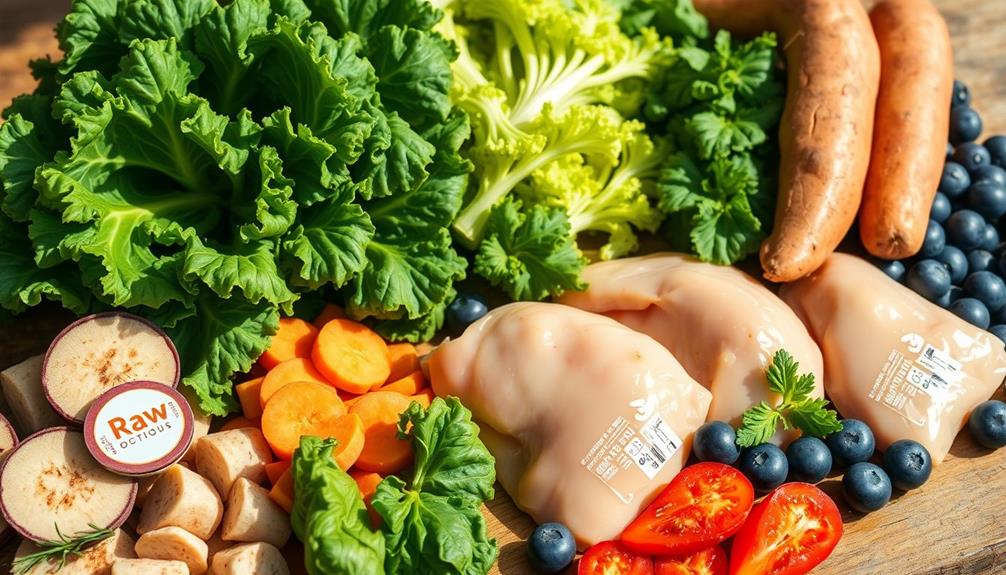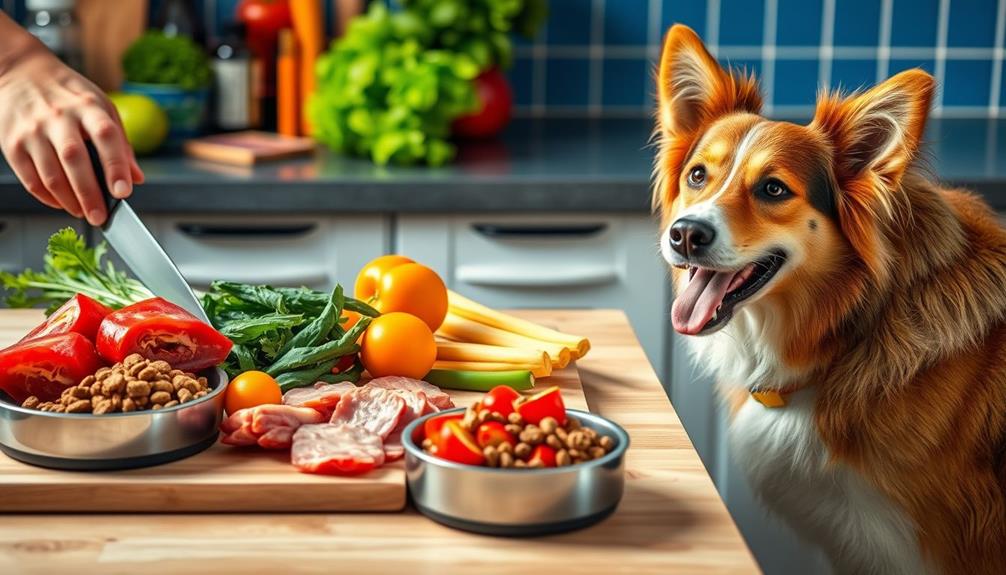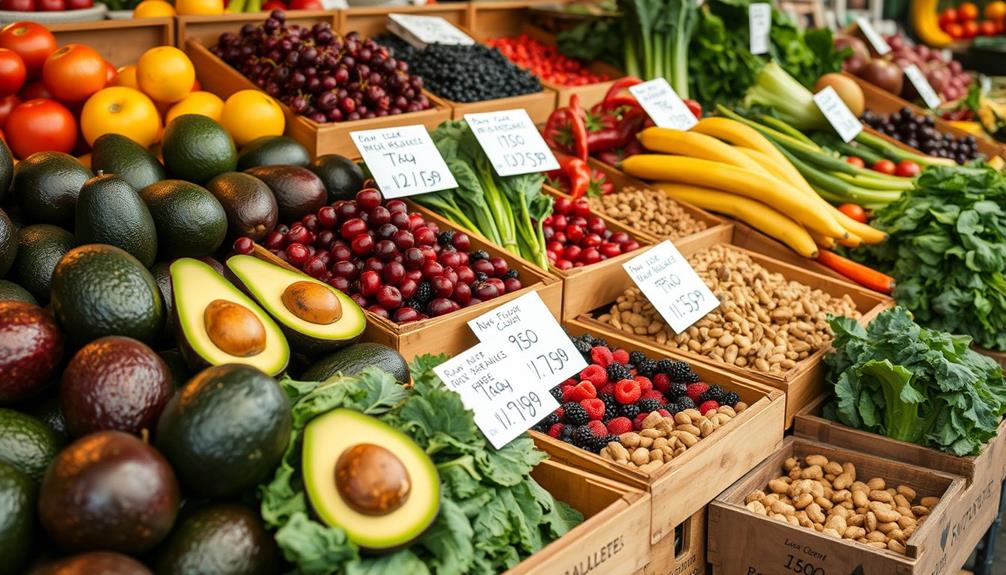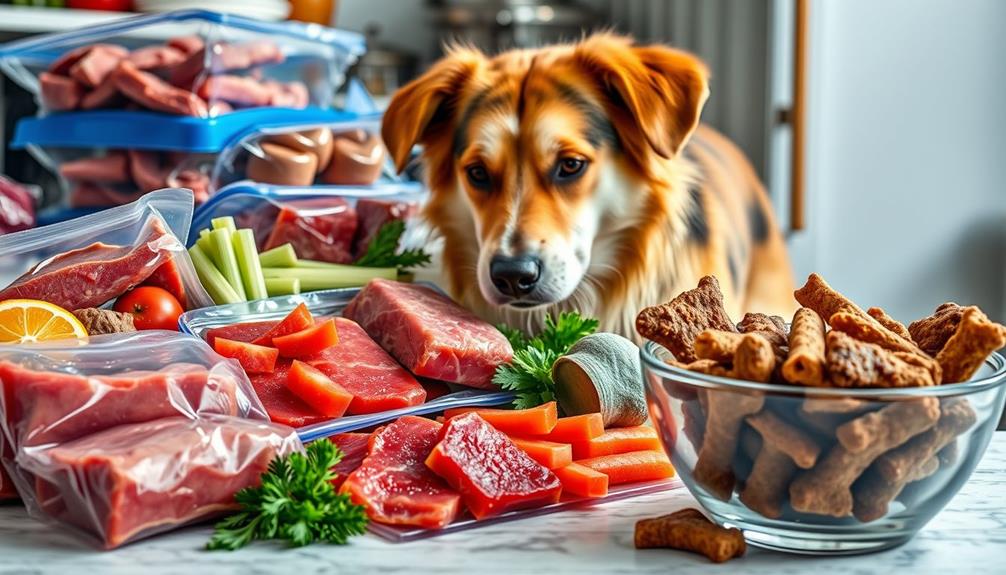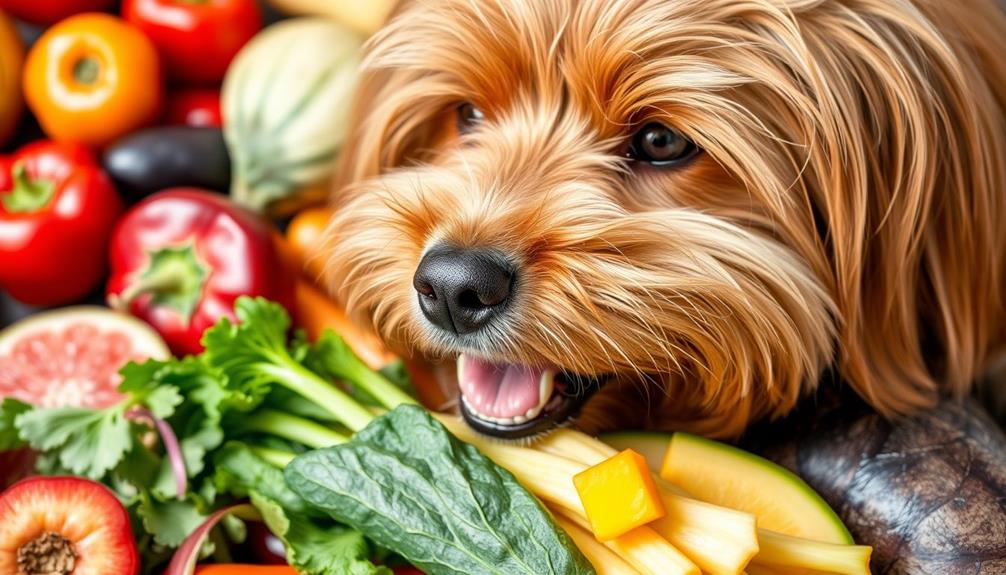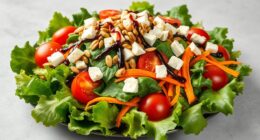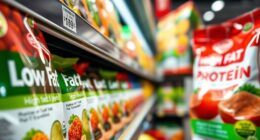When choosing raw foods for your dog, focus on high-quality muscle meats like chicken, turkey, and fish, which offer essential protein. Include nutrient-rich organ meats such as liver and heart for crucial vitamins and minerals. To complete the diet, add fresh vegetables like leafy greens, carrots, and sweet potatoes. Aim for a balanced ratio of 5 parts muscle meat, 1 part bone, 1 part organ, and 1 part vegetables to guarantee nutrition is on point. If you're curious about specific brands or best practices, you'll discover even more tailored tips for your dog's health.
Key Takeaways
- Muscle Meat: Chicken, turkey, and fish are excellent protein sources, providing essential nutrients for your dog's health.
- Organ Meats: Liver, heart, and kidney offer vital vitamins and minerals, supporting immune function and overall well-being.
- Bones: Raw meaty bones promote dental health and provide calcium, essential for strong bones and teeth.
- Vegetables: Leafy greens, carrots, and pumpkin contribute necessary fiber and antioxidants, enhancing digestion and overall nutrition.
- Variety: Combining different protein sources and organ meats ensures a well-rounded diet, preventing nutrient deficiencies.
Understanding Raw Dog Food
Understanding raw dog food is fundamental for providing your furry friend with a diet that aligns with their natural instincts. Raw dog food mimics a dog's natural diet, combining muscle meat, organ meats, bones, and some plant matter to meet their nutritional needs.
A balanced raw diet typically consists of 5 parts muscle meat, 1 part bone, 1 part organ, and 1 part vegetables. This ratio guarantees your dog receives essential nutrients for peak health. Additionally, it's important to evaluate the overall health and specific dietary needs of your dog, as financial considerations for pet care can also play a role in choosing the right food options financial considerations for pet care.
Dogs have a highly acidic stomach, which helps digest raw meat effectively. Their saliva lacks amylase, indicating they prefer proteins over carbohydrates. Including organ meats, especially liver, is essential as it offers important vitamins and minerals significant for your dog's overall well-being.
When moving to raw dog food, it's important to do so gradually over 7-10 days. This adjustment period allows your dog's digestive system to adapt, minimizing the risk of gastrointestinal upset.
Benefits of Raw Feeding

Switching your dog to a raw diet can greatly improve their digestive health, leading to firmer stools and easier digestion.
A raw diet can also support a healthy immune system, which is vital for overall well-being, as outlined in cold medications overview.
You might also notice a shinier coat, thanks to the high-quality fats and nutrients found in raw meats.
Improved Digestive Health
A raw food diet can greatly improve your dog's digestive health. By switching to raw dog food, you're likely to notice firmer stools, as the natural ingredients are easier for your dog to digest compared to processed kibble. This results in less waste production and a healthier gut.
Additionally, proper nutrition can play an essential role in maintaining overall health, similar to how a balanced diet benefits hamster care and costs.
Many owners report improved digestion and nutrient absorption with raw feeding. The enzymes and live bacteria found in raw diets are beneficial for gut health, helping to break down food more efficiently. The high moisture content in these foods also aids in maintaining hydration, which is key for preventing constipation.
Moreover, raw diets often include natural fibers from vegetables, enhancing gut motility and preventing common digestive issues such as bloating and gas. By mimicking your dog's ancestral diet, you're aligning their meals with their biological needs, which can greatly reduce gastrointestinal problems and support overall digestive wellness.
Incorporating raw food into your dog's diet isn't just about feeding; it's about fostering better digestive health and ensuring a happier, healthier pup.
Enhanced Coat Quality
One of the most noticeable benefits of a raw food diet for dogs is the enhanced quality of their coat. When you switch to raw dog food, you're likely to see a shinier, healthier coat thanks to the inclusion of high-quality fats and proteins.
These essential nutrients support both skin and fur, making a significant difference in coat health. Additionally, incorporating a balanced diet can positively impact your dog's overall health and well-being, which is essential for maintaining a vibrant coat.
Understanding common financial terms related to budgeting for your pet's nutrition can also help guarantee you make informed choices.
Here are four key ways raw feeding improves coat quality:
- Omega-3 and Omega-6 Fatty Acids: Found in fish and organ meats, these fatty acids maintain coat luster and reduce dryness.
- Natural Ingredients: The absence of fillers and artificial additives prevents skin irritations and allergies, which can negatively impact coat health.
- Nutrient-Rich: Raw organ meats are packed with zinc and biotin, essential for promoting growth and overall vitality.
- Improved Coat Texture: Many pet owners notice reduced shedding and a smoother coat after making the switch to a raw diet.
Nutritional Balance Essentials
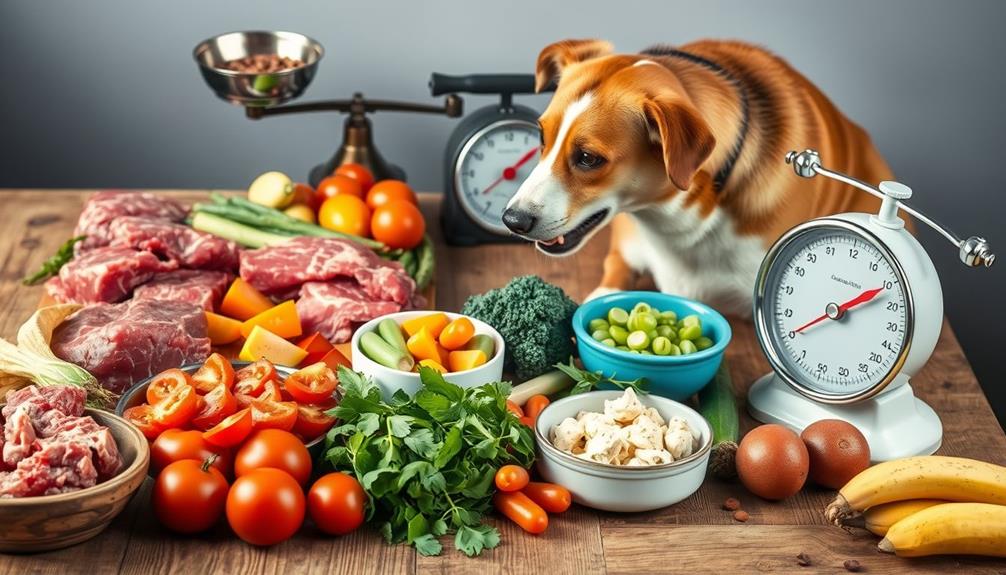
To achieve nutritional balance in your dog's raw food diet, it's essential to follow a well-structured ratio. Ideally, aim for 5 parts meat, 1 part bone, 1 part organ meats, and 1 part vegetables. This basic framework allows for flexibility, like variations such as an 8:1:1 ratio, while ensuring your dog receives necessary nutrients.
Incorporating high-quality protein sources, like those found in healthy dog snacks, helps to prevent nutrient deficiencies and keeps your dog's diet well-rounded. Organ meats, especially liver, are critical for providing essential vitamins and minerals, but remember to use them in moderation to prevent overfeeding.
Incorporating a variety of protein sources—like chicken, beef, and fish—helps to prevent nutrient deficiencies and keeps your dog's diet well-rounded. Adding small amounts of vegetables, such as leafy greens and carrots, contributes necessary fiber and phytonutrients, enhancing the overall nutritional value of the raw dog food.
Don't forget about supplementation! Items like seaweed can boost vitamins and minerals, offering additional health benefits.
Best Meat Choices
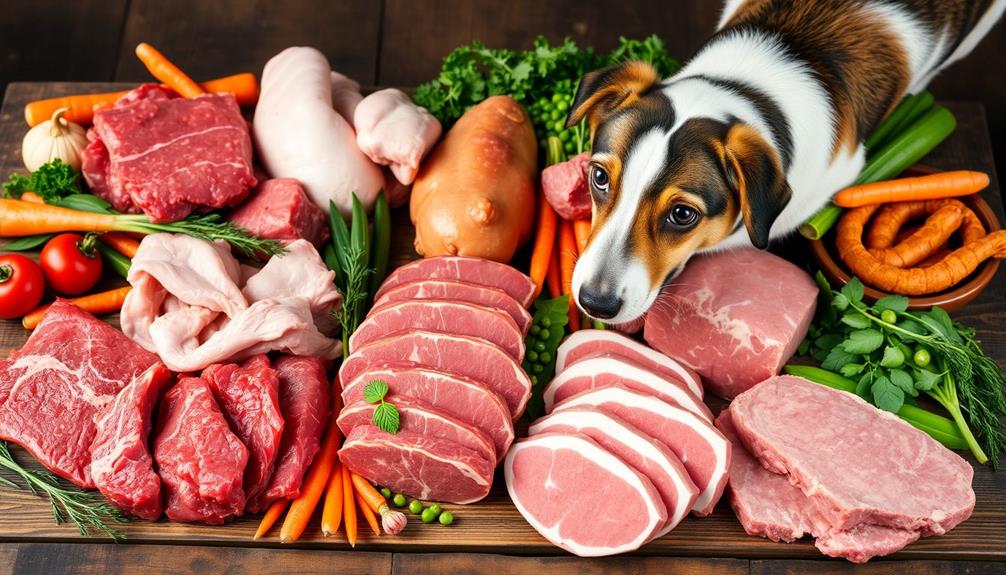
When choosing the best meat for your dog's raw food diet, consider options like chicken, turkey, duck, pork, beef, and fish. These raw meats provide the essential protein and nutrients that support a balanced diet tailored to your dog's carnivorous nature.
Incorporating certain essential oils can also promote your dog's overall health, as seen with essential oils for respiratory health that can support their immune system.
Here are some top picks:
- Chicken: A popular choice, chicken is rich in protein and readily available.
- Turkey: Leaner than chicken, turkey is another excellent source of protein.
- Duck: This flavorful option offers a unique taste and additional nutrients.
- Fish: Always freeze fish before feeding to eliminate potential parasites; it's great for omega-3 fatty acids.
Incorporating muscle meat like heart and tripe enhances the protein content while promoting dental health, especially when bones are included.
Organ meats, such as liver and kidney, are vital but should be fed in moderation to avoid nutrient excesses.
Top Organ Selections
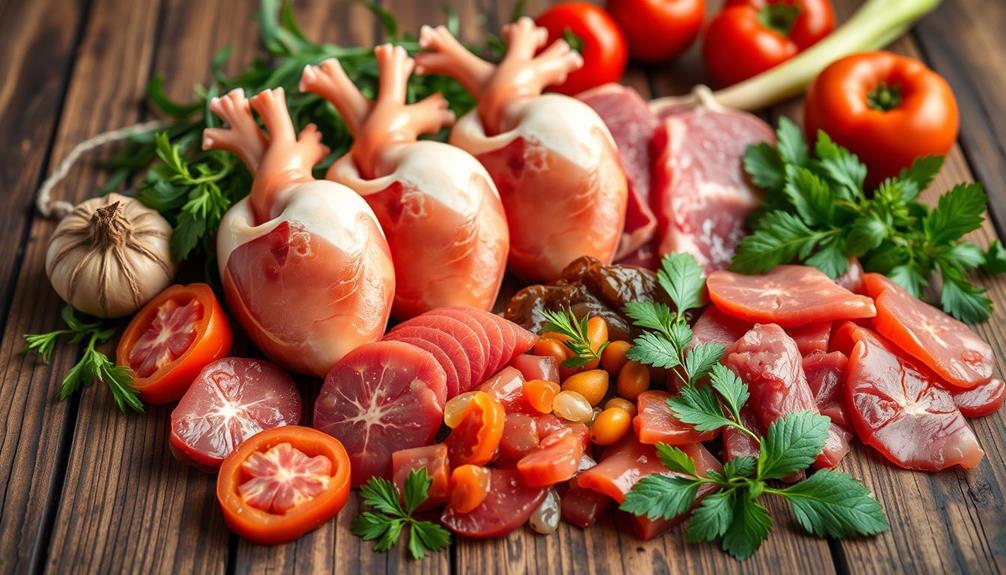
Choosing the right organ meats is key to enhancing your dog's raw food diet. Organ meats are essential for providing important nutrients, and incorporating variety guarantees a well-rounded nutrient profile. The liver tops the list, packed with vitamin A, B vitamins, and iron. Kidneys and hearts also play significant roles; kidneys supply important minerals like phosphorus, while hearts are rich in taurine, supporting heart health.
To help you choose the best organ selections, here's a quick overview:
| Organ Meat | Key Nutrient | Benefits |
|---|---|---|
| Liver | Vitamin A, Iron | Supports vision and immunity |
| Kidney | Phosphorus | Aids in bone health |
| Heart | Taurine | Promotes heart health |
| Tripe | Probiotics | Offers digestive benefits |
Recommended Vegetables
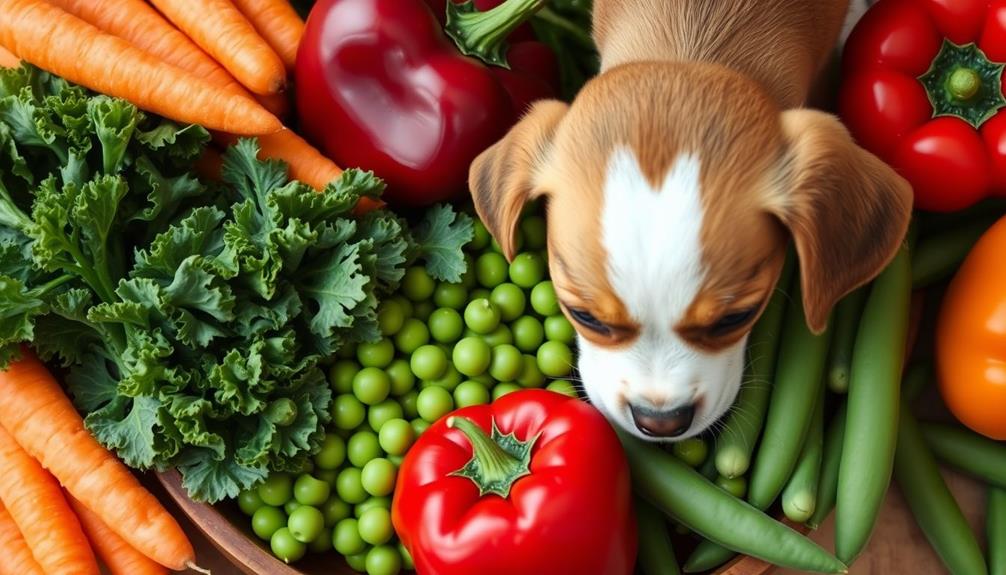
What vegetables can you include in your dog's raw food diet to boost their health? Incorporating recommended vegetables can greatly enhance your dog's nutrition. Here are some top choices:
- Leafy Greens: Spinach and kale provide essential vitamins and antioxidants, supporting overall health. Additionally, these greens may help improve emotional stability, as a balanced diet can positively affect mood and behavior, similar to how emotional dysregulation is a key characteristic of Borderline Personality Disorder.
- Green Beans: Low in calories and high in fiber, they're perfect for weight management and promote digestive health.
- Carrots: Rich in beta-carotene, carrots promote good vision and healthy skin. Plus, they help clean your dog's teeth when chewed.
- Peas: A great source of protein, vitamins, and minerals while being low in fat, peas contribute to a balanced diet.
When adding these veggies to your dog's meals, always start with small quantities to assess their tolerance. This way, you can guarantee they don't experience any digestive upset.
Including these recommended vegetables in your dog's raw food diet can make a positive difference, supporting both their health and well-being.
Popular Raw Dog Food Brands
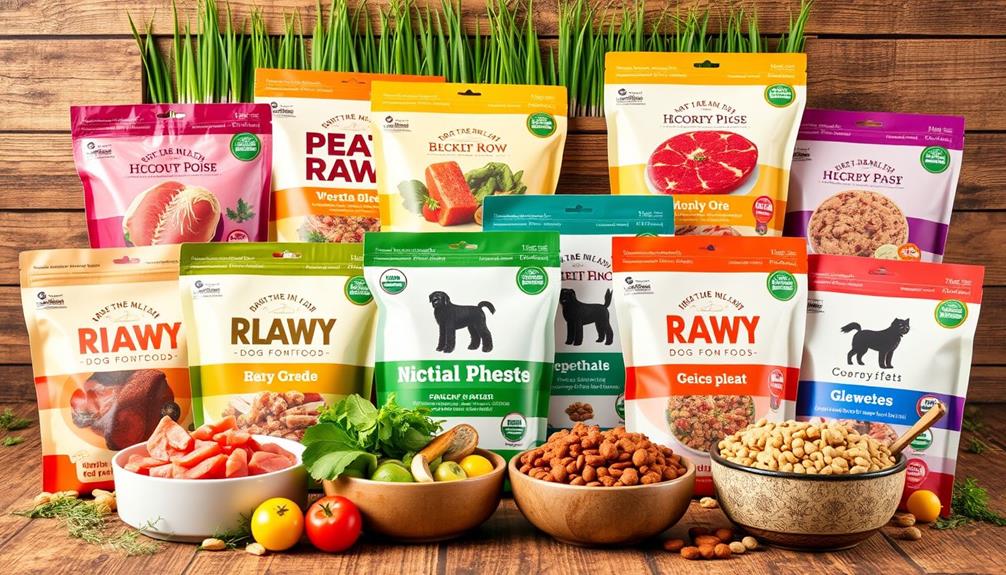
Many dog owners frequently seek high-quality raw dog food brands to guarantee their pets receive ideal nutrition. When it comes to popular raw dog food brands, We Feed Raw stands out with its impressive nutritional profile of 49% protein, 25% fat, and 18% carbohydrates. This makes it a favorite among raw dog food enthusiasts.
Additionally, it's important to take into account the balance of nutrients in your dog's diet to avoid deficiencies, similar to how juice diets can lead to imbalances for humans.
Another excellent choice is Paleo Ridge, a multi-award-winning brand that offers complete and complementary options, including the Classic range (80/10/10) and Paleo Plus range (95% meat with superfoods).
Naturaw is recognized for its commitment to sustainability, providing balanced raw options like the Original (80/10/10) and Forage collections, all in compostable packaging.
If you're looking for a brand that emphasizes balanced nutrition, Dr. Marty comes highly recommended, featuring a formula with 39% protein, 29% fat, and 24% carbohydrates.
Finally, consider Stella & Chewy, particularly their Absolutely Rabbit Dinner Patties, boasting a remarkable nutritional breakdown of 52% protein, 33% fat, and only 7% carbohydrates.
With these options, you can confidently choose high-quality raw dog foods that cater to your pup's dietary needs. There are many reputable brands that offer a variety of raw dog food options, including those specifically formulated for different breeds, sizes, and activity levels. By selecting the best diet for dogs, you can ensure that your furry friend is receiving all the essential nutrients and nourishment they need to thrive. Whether you opt for a balanced mix of meats, fruits, and vegetables or a specialized raw diet tailored to specific health concerns, providing high-quality raw dog food is a great way to support your pup’s overall well-being.
Transitioning to Raw Diet
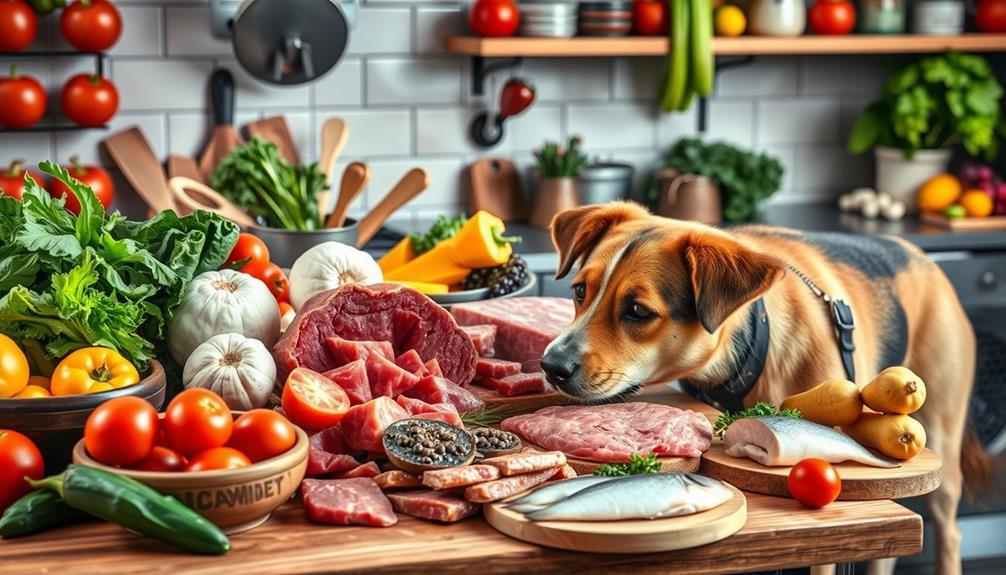
Shifting to a raw diet can be an exciting journey for both you and your dog, but it requires careful planning to guarantee a smooth process.
This change can also encourage deeper self-reflection on your dog's nutritional needs and overall well-being, as the philosophical exploration of raw feeding challenges conventional views on pet diets.
Moving to a raw diet should ideally take 7-10 days, allowing your dog to adjust without digestive upset. Here's how to get started:
- Start Slow: Mix 20% raw dog food with 80% of your dog's current diet for the first 1-3 days.
- Gradually Increase: Slowly increase the raw portion while monitoring your dog's reactions over the following days.
- Daily Portions: For healthy adult dogs, aim for daily raw food portions that range from 2-5% of their body weight. Puppies may require up to 10% due to their growth needs.
- Consult a Veterinarian: It's crucial to discuss this change with a veterinarian to guarantee your dog's nutritional needs are being met effectively.
Safety Considerations
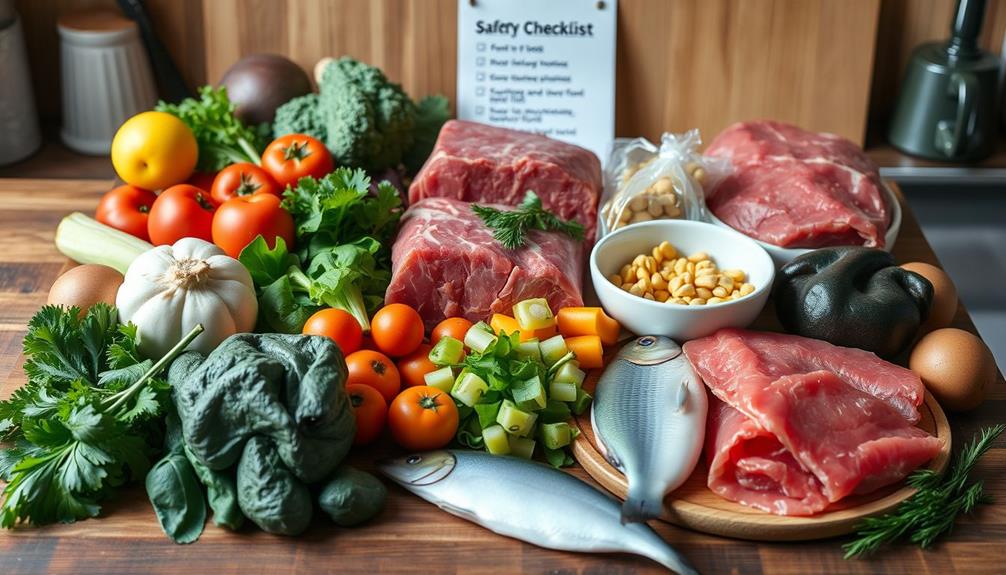
When feeding your dog raw meat, it's essential to handle it safely to prevent any health risks. Incorporating a variety of raw foods can enhance your dog's diet, but it's important to guarantee that these foods are properly prepared and stored.
Make sure to freeze the meat for at least three days to eliminate potential parasites and bacteria. By practicing good hygiene and sourcing from reputable suppliers, you can keep your furry friend safe and healthy.
Consider exploring mastering the art of bug out bags for tips on emergency preparedness that could also apply to your dog's nutrition.
Handling Raw Meat Safely
Guaranteeing safety is paramount when handling raw meat for your dog. You want to minimize the risk of harmful bacteria in raw ingredients, so follow these key steps for handling raw meat safely:
- Freeze raw meat: Always freeze raw meat for at least 24 hours before feeding it to your dog. This helps kill potential parasites and bacteria.
- Prevent cross-contamination: Use separate cutting boards and utensils specifically for raw meat. This prevents cross-contamination with other foods, especially those that are cooked or meant for human consumption.
- Wash your hands: After handling raw meat, wash your hands thoroughly with soap and water. This is essential to eliminate any harmful bacteria like Salmonella or E. coli.
- Store raw meat properly: Use airtight containers to store raw meat in the refrigerator. Keep it for only 1-2 days before freezing or discarding to maintain freshness and safety.
Additionally, always clean surfaces and utensils that come into contact with raw meat using hot, soapy water or a disinfectant to guarantee that no pathogens linger.
Your diligence in these practices keeps your dog safe and healthy.
Freezing for Parasite Control
To keep your dog safe from harmful parasites, freezing raw meat is an essential step in your food preparation process. This method effectively kills parasites like tapeworms and roundworms, ensuring that your raw dog food is safe to serve. For best results, follow freezing guidelines by keeping the meat at -4°F (-20°C) or lower for at least 24 hours.
While you might worry about the nutritional quality of frozen meat, rest assured that freezing doesn't greatly affect its nutrients. Your dog will still enjoy a healthy, nutrient-rich diet.
However, it's important to handle and thaw frozen raw meat properly to minimize contamination risks. Always wash your hands and surfaces thoroughly before and after handling.
As a pet owner, being aware of these food safety practices is essential. Improper freezing or thawing can lead to health risks not just for your dog but also for you.
Frequently Asked Questions
What Is the Most Healthy Raw Food for Dogs?
When considering the healthiest raw food for your dog, focus on high-quality meats, balanced organ options like liver, and nutrient-rich vegetables. Incorporating variety guarantees your pup gets essential vitamins and minerals for peak health.
What Can I Top My Dogs Raw Food With?
You can top your dog's raw food with medicinal herbs like turmeric, dark berries for antioxidants, a bit of seaweed for nutrients, raw eggs for healthy fats, and various vegetables to enhance digestion and overall well-being.
How Do I Know What Raw Food to Feed My Dog?
To determine what raw food to feed your dog, consider a balanced diet with quality proteins, bones, and organs. Monitor your dog's health and adjust portions based on their weight and activity level.
Do Vets Recommend a Raw Diet for Dogs?
Many vets have mixed opinions on raw diets for dogs. While some support it for healthy pets, others caution against potential health risks. Always consult your veterinarian to guarantee your dog's nutritional needs are met safely.
Conclusion
In the journey of nourishing your dog, think of raw food as a vibrant garden, bursting with life and energy. By choosing the right meats, organs, and veggies, you're planting seeds for your pup's health and happiness. As you shift to this new diet, remember that every meal is a step on the path to wellness. So, embrace the adventure, keep safety in mind, and watch your furry friend flourish like a blooming flower under the sun.

